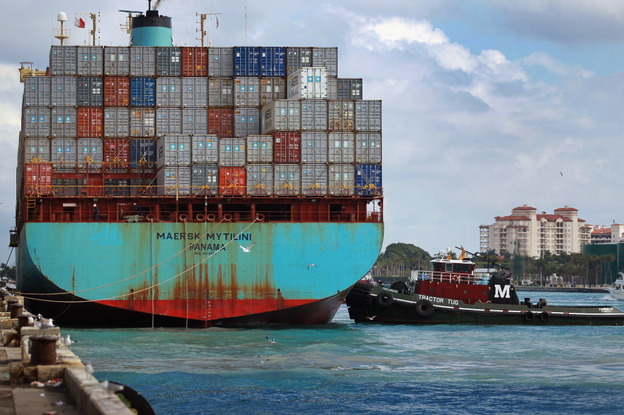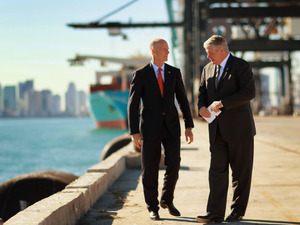 Joe Raedle/Getty Images
Joe Raedle/Getty Images A container ship prepares to leave the Port of Miami in 2010. Plans are under way to deepen the port to 50 feet to attract bigger ships coming from the Panama Canal, but they've recently been put on hold after environmental groups filed a petition.
In 2014, when expansion of the Panama Canal is complete, a new generation of superlarge cargo ships will begin calling on the East Coast. Cities like New York; Savannah, Ga.; and Miami are vying for the new business, as they race to deepen their ports and expand their facilities to accommodate the new ships.
But some of the cities are running into significant challenges. In Miami, where plans are under way to deepen the port to 50 feet, dredging is a hot topic. Some see it as a great business opportunity. To others, it's a threat to the environment.
The director of Miami's port, Bill Johnson, is one of those who's excited: "We are the only port south of Norfolk, Va. ... that has full approval from the U.S. Congress to go to that depth. It is the game changer," he says.
When you kill the grass beds, there's no filtration. There's nothing to hold the sediment that's there down anymore.
After expansion of the Panama Canal is complete in 2014, ports on the Gulf and East Coast will see more so-called post-Panamax vessels ? ships that carry two or three times the load of standard freighters.
Miami expects to be ready, if it gets the green light to begin dredging its port. But it recently hit a snag: Environmental groups, concerned about how the dredging would affect Biscayne Bay, filed a petition with state regulators that, for now, has put the project on hold.
"We're going to lose the bay. It won't survive it," says Dan Kipnis, a former charter boat captain and now an environmental activist who has long worked on Biscayne Bay.
Blasting In The Bay
Kipnis grew up here on nearby Palm Island, and was active in efforts in the 1970s and '80s to restore the health of the bay. Today, the water is cleaner than in decades past, and the bay is a busy place.
Along with the cargo ships, it's one of the world's busiest ports for cruise ships. There are also sailboats, kayaks and jet skis and, Kipnis says, excellent fishing.
"I will catch you groupers that weigh 12 pounds, and hog snappers and Spanish mackerel," he says. "It's just amazing the amount of life we've got here ? forgetting crabs and shrimp and all that."
Kipnis has joined with Biscayne Bay Waterkeeper and the Tropical Audubon Society in asking Florida to make sure the port dredging project won't damage the bay.
 Enlarge Joe Raedle/Getty Images
Enlarge Joe Raedle/Getty Images Port of Miami Director Bill Johnson (right) speaks to Florida Gov. Rick Scott at the port. "It is the game changer," Johnson says of the city's plan to deepen its port to accept new, larger ships from the Panama Canal.
Joe Raedle/Getty ImagesPort of Miami Director Bill Johnson (right) speaks to Florida Gov. Rick Scott at the port. "It is the game changer," Johnson says of the city's plan to deepen its port to accept new, larger ships from the Panama Canal.
The bottom of Biscayne Bay isn't mud, but limestone. To make the shipping channel wider and deeper, the Army Corps of Engineers wants to conduct nearly two years of underwater blasting.
Kipnis is worried about the amount of sediment the dredging will put into the bay's crystal clear water.
"If you lift all this silt up year in and year out for two years, and get it in suspension, you're going to kill the grass beds. When you kill the grass beds, there's no filtration. There's nothing to hold the sediment that's there down anymore," he says.
At a recent port presentation, Johnson, the Miami port chief, said he's willing to work with environmental groups to make sure the dredging is done in a way that addresses their concerns.
"We're not about killing manatees; we're not about polluting the bay. We're about doing things that are right," Johnson said.
East Coast Cities Race To Dredge
Miami is not the only city where port dredging plans are controversial. In Georgia, a plan to dredge Savannah's port has riled up environmentalists and politicians. Environmental groups are concerned about some of the same sediment issues raised in Miami.
Regulators in South Carolina, just across the Savannah River, at first moved to block the dredging. But then South Carolina Gov. Nikki Haley intervened. In part because of her help, Georgia was able to negotiate a deal with South Carolina regulators that allows the dredging to go forward.
Some in the state felt that Haley was unfairly helping the competition. South Carolina is working to expand Charleston and its other ports to accommodate the new post-Panamax ships. At a news conference, Haley said there will be enough business for ports in both states.
"Those Panamax ships are coming through Charleston, and it is going to be so vibrant and so strong, that the overflow is going to go to Jasper, [S.C.], and Jasper is going to be a great port," Haley says. "Without question, the ports are the best thing we've got going. It's an opportunity waiting to happen."
That's a message you can hear in New Orleans, Baltimore, and other ports along the Gulf and Atlantic coasts. So far, only one port ? Norfolk ? is deep enough to accommodate the new superlarge ships. By 2014, a handful of other cities hopes to be ready. But there's a lot of work to be done before then.
In New York, the port is deep enough, but there's another problem: the Bayonne Bridge, which is currently too low to allow the new container-laden ships to pass. To fix that, the Port Authority is planning to raise the bridge 64 feet ? a job that will take more than $1 billion and five years to complete.
consumer financial protection bureau casey anthony video recess appointment eastman kodak eastman kodak richard cordray shannon de lima
No comments:
Post a Comment
Note: Only a member of this blog may post a comment.